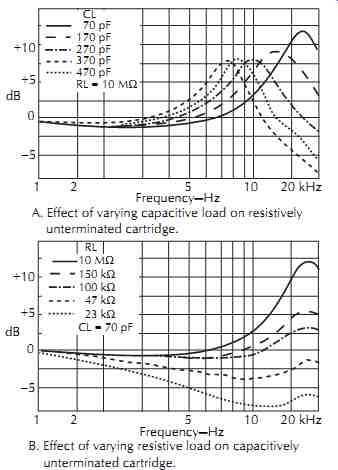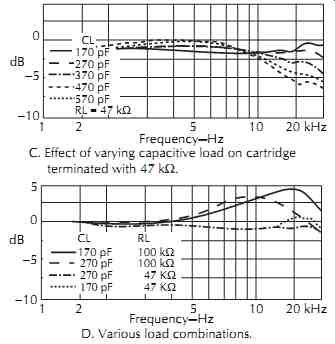|
|
Phonograph cartridges require a special type of amplification to reproduce the recorded sound the way it existed during the recording session. The electrical signals from the cartridge, measuring only a few millivolts rms have to be amplified into signals of many volts.
This has to be accomplished with:
- • Minimum distortion.
- • Flat frequency response.
- • Excellent SNR.
The phono preamplifier has to amplify a cartridge signal without:
- • Changing its phase.
- • Adding more than a small percentage of harmonic and intermodulation distortion.
- • Adding to the noise content of the original signal from the cartridge.
- • Needing enough reserve power to handle any unusually high transient signals.
The average required voltage amplification is 40-50 dB and is dependent on the output of the cartridge. The dynamic cartridge produces 4-5 mV of output for the average recording signal. A preamplifier gain of 45 dB will boost the signal output to nearly 1 V, the level required to drive most power amplifiers to full output. The noise contribution of the cartridge and of the recording medium requires the preamplifier noise level to be at least 70 dB below the average input signal of 10 mV.
The frequency response of the circuit should follow the RIAA characteristics, with the low frequencies boosted about 20 dB, and the high frequencies attenuated by the same amount, with respect to 1 kHz, which implies that the preamplifier with 40 dB of gain at 1 kHz will have as much as 60 dB of gain at 20 Hz and only 20 dB of gain at 20 kHz.
It is not unusual for a cartridge producing an output of several millivolts for the average modulation to produce 100 mV voltage peaks. Cartridges are designed to produce an output voltage of around 1 mV for each centimeter per second of recorded velocity or for the average recorded level of 5 cm/s, the cartridge output is 5 mV. Some preamplifier circuits when overloaded by fast spikes can recover in a matter of microseconds and resume their normal operation while others are incapable of recovering fast and once overloaded stay in this unbalanced state long enough to produce audible distortion of lower-level signals that may follow. Direct coupled stages, which don't employ large capacitors and inductors, have much higher slew rates and consequently react much faster and with less distortion to audio signals.
The average moving-coil cartridge produces from 0.1-0.6 mV output with the source impedance of a few ohms and an inductance of a few millihenries, so 20-30 dB of additional voltage gain is required from the pre-preamplifier. Because the output level of the cartridge is so low, an extra demand for low-noise performance is placed on the circuit. To maintain the same SNR as in high-output moving-magnet cartridges, the pre-preamplifier (or head-amplifier) circuit should have 20 dB lower noise than the preamplifier for the moving-magnet cartridges. One of the ways to achieve this lower noise is by using a step-up transformer. The power supply for the low-level amplifiers requires excellent regulation and extremely low ripple voltage.
The preamplifier input for the moving-magnet cartridges requires a 47 k-Ohm input resistance and a low, preferably adjustable, capacitive load. The proper termination of the moving-magnet cartridge is very important for the correct performance of the transducer.
Moving-magnet cartridges have a resistive and inductive nature, so designers specify the capacitive load. If the specified capacitive load is higher than the total capacity of the circuit, the preamplifier should have a provision to add capacitance to the cartridge termination as required. If the total capacitance is larger than needed, cables can be made shorter or replaced with ones having lower capacitance.
===========


FIG. 27. Effect of cartridge loading on frequency response.
A. Effect of varying capacitive load on resistively unterminated cartridge.
B. Effect of varying resistive load on capacitively unterminated cartridge.
C. Effect of varying capacitive load on cartridge terminated with 47 k-Ohm.
D. Various load combinations.
============